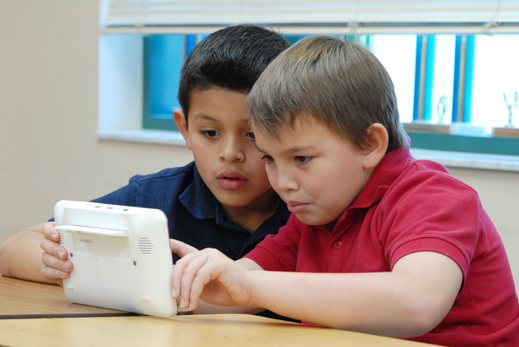Tablet Makers Pursue Public Schools
Every fifth-grader at Barron Park Elementary School in Palo Alto has an iPad—and it’s not because their parents plunked down $499 apiece to buy them.

The students in Barron Park’s two fifth-grade classes are part of a pilot program that began this fall, supported by funds from a local tax measure. They use the tablet computers for solving math problems and making videos on field trips, checking the devices out each morning and returning them to their teachers at the end of the day. Soon, they’ll be allowed to take the gadgets home.
Educational technology teacher Smita Kolhatkar believes the tablets help students with lessons, improve memory and language skills, and cause them to act more independently. “It’s simply amazing to see the level of engagement and excitement with the children,” she says.
The excitement among tablet makers is almost as great. Research firm IDC says global shipments of tablets will reach 177 million this year, and 11 million of them were purchased by businesses or government agencies rather than consumers. Of those, IDC analyst Tom Mainelli says, the “vast majority” were sold to schools.
Mainelli thinks that within a few years all U.S. students will have some access to a tablet at school. With 55 million students in the country’s elementary and secondary schools, according to the National Center for Education Statistics, that’s a lot of potential sales. And it’s not just a one-time product push: beyond selling tablets to schools and districts, tablet makers see a chance to set up future sales by establishing brand loyalty with young users.
“All these guys see huge opportunities here,” Mainelli says.
Because of the spread of digital texts and curricula, including free educational software, public K-12 schools are now starting to issue tablet computers as they once did textbooks and free lunches. The superintendent of the Los Angeles Unified School District, the second-largest district in the country with over 640,000 students, has said he wants to have a tablet for every student and teacher by next school year. TheMcAllen Independent School District, located in a Texas town on the Mexican border, is handing out an iPad to each of its students in first through 12th grades and an iPod Touch to each child in preschool or kindergarten. The cost of that project, including Wi-Fi spots and about 25,000 devices, is $20 million.
Far and away the most successful tablet maker in the education market has been Apple. In its quarterly report released in July, the company said it sold 17 million iPads, a million of them to schools. Apple hasn’t reported education numbers since then, but it did unveil a smaller, cheaper model in October that it expects will also appeal to students and educators: the $329 iPad Mini. The company also introduced a new version of its iBooks Author software, which lets publishers create digital textbooks for the iPad.
CEO Tim Cook said that iBooks textbooks are now available for 80 percent of the core U.S. high-school curriculum and are being used in more than 2,500 classrooms. “We saw this early on,” he said during the unveiling of the iPad Mini.
Amazon also highlighted its interest in the education market in late October with the debut of Whispercast, a service that aims to make it easier to manage its Kindle e-readers en masse. Teachers can use it to do things like set up different reading groups with the tablets or block students from access to the Web. Although Amazon has never divulged its e-reader or tablet sales, Jay Marine, vice president of product management for the Kindle, says thousands of schools are using Amazon’s Kindle Fire tablets and e-readers and that the company sees the education market as “a meaningful business opportunity.”
It’s not only large companies hoping to make headway in this market. Smaller companies making tablets aimed specifically at the education market include CurriculumLoft, which makes the Kuno tablet, and Brainchild, which sells the Kineo.
Brainchild CEO Jeff Cameron says his company’s $299 tablet, which runs on Google’s Android software, is used in a couple of thousand school districts. He thinks it’s better than mass-market devices because it was built for educational use. Unlike most tablets, the Kineo has a replaceable battery, which could give the machines a longer lifespan. Its touch screen is meant to withstand spills, and it has more physical buttons than an iPad does.
Cameron cautions that while the education market may look exciting to consumer electronics companies, it can be exhausting to deal with public-sector budgets and long purchasing cycles. “I think it’s going to be more difficult than the consumer companies believe,” he says.
Keep Reading
Most Popular
Large language models can do jaw-dropping things. But nobody knows exactly why.
And that's a problem. Figuring it out is one of the biggest scientific puzzles of our time and a crucial step towards controlling more powerful future models.
The problem with plug-in hybrids? Their drivers.
Plug-in hybrids are often sold as a transition to EVs, but new data from Europe shows we’re still underestimating the emissions they produce.
Google DeepMind’s new generative model makes Super Mario–like games from scratch
Genie learns how to control games by watching hours and hours of video. It could help train next-gen robots too.
How scientists traced a mysterious covid case back to six toilets
When wastewater surveillance turns into a hunt for a single infected individual, the ethics get tricky.
Stay connected
Get the latest updates from
MIT Technology Review
Discover special offers, top stories, upcoming events, and more.